5-Series PHEVs—The Ultimate Plug-in Machines?
The auto industry has been slowly transitioning toward battery-powered transportation, but each company has its own way of doing it. BMW, which jumped in early with the i3 and i8 in 2014, has been slow to move to pure electrics, but now offers plug-in hybrid options on several popular models, including the midsize 530e sedan and X5 xDrive45e crossover, both of which I recently tested.
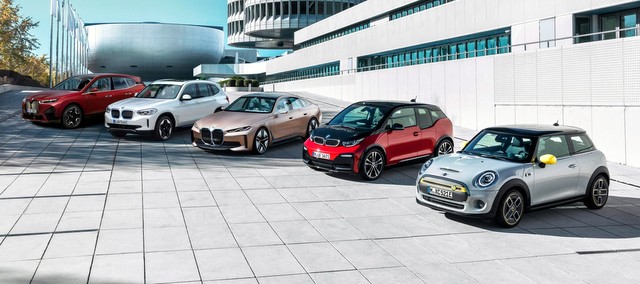
Three Different Paths Towards Electric
Before diving into the two Bimmers, let’s look at the different ways that car companies can approach the gasoline-to-electricity transition, from all-in to not-quite-ready-yet, the middle path. I’m just hitting high spots here to make the point.
All-in is how Tesla, a California startup, has done it since day one. First, they electrified a small two-seat sports car on a borrowed Lotus platform. Then, they took what they learned and introduced their mass market flagship Model S sedan. The smaller, more affordable Model 3 sedan and Model Y hatchback followed, putting Teslas—every one all-electric—into the hands of a much wider clientele.
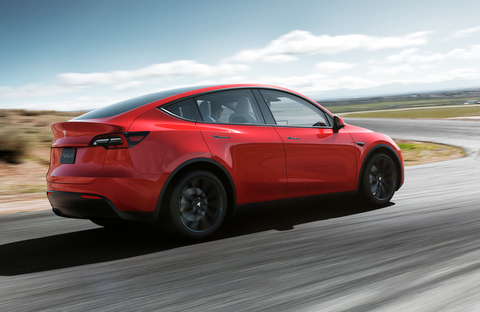
The middle path recognizes that electric cars are not profitable yet (Tesla’s only made a profit based on sales of its electric vehicle production credits), but companies like General Motors, Ford, Nissan and Volkswagen don’t want to be left out in the future. Things started rolling about a decade ago, when Nissan bravely introduced the all-electric Leaf and GM brought out the clever Volt plug-in hybrid. Ford and VW electrified existing compact hatchbacks, replacing engines with motors in the compact Focus and Golf, respectively. There are other examples, such as Mercedes-Benz’s B-class EV and more recent offerings from Audi.
GM debuted the all-new Bolt EV four years ago, and recently announced an all-electric future, with some desirable cars in the works, from the GMC Hummer EV pickup and Cadillac Lyriq crossover as well as the Bolt EUV crossover. Ford is debuting its beautiful and powerful Mustang Mach-E now and has put a hybrid in the F-150 pickup, with a full EV version on the way. VW is finally rolling out the excellent ID.4 crossover. The Nissan Ariya crossover is imminent. So, there’s progress.
Another way to take the middle path is to avoid EVs but proliferate hybrids. Toyota has taken this approach, spreading its pioneering Prius hybrid technology across its model mix, including the Avalon, Camry and Corolla sedans, and RAV4 and Highlander crossovers. It’s also amortized the cost of the technology by using it in numerous Lexus models.
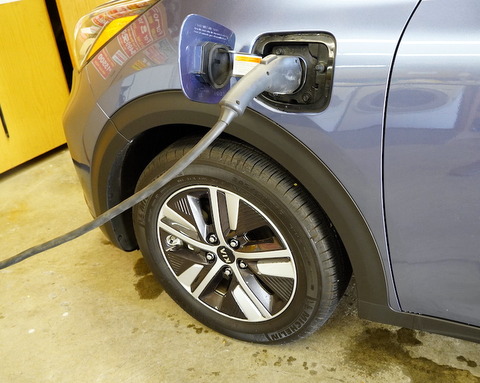
A few years ago, the Korean brands introduced the Hyundai Ioniq and Kona and Kia Niro models that let you choose hybrid, plug-in hybrid, or battery electric flavors. Both brands added similar choices in their mainstream midsize sedans—the Hyundai Sonata and Kia Optima. Both companies have recently committed to full lines of EVs over the next few years.
On the “just getting started” side you’ll find worthy manufacturers like Subaru and Mazda, who don’t have the cash to build an all-electric car. However, they are collaborating with larger companies, such as Subaru has already done with Toyota on its plug-in Crosstrek Hybrid. Mazda just introduced an electric version of its MX-30 crossover, but it’s not available in the U.S yet. It will be Mazda’s first EV in America when it arrives, although we may only get a plug-in hybrid version that also uses Toyota technology.
BMW’s Plug-In Hybrids
Getting back to BMW, it has its plug-in hybrids and plans for new all-electric models, including the i4 sedan and iX crossover. Currently it offers the iX3 small electric crossover in Europe. Today, you can contact your American BMW retailer and buy or lease a 530e or X5 xDrive45e plug-in hybrid (or any of nine PHEV models—see note at end of story). I drove both over the last few weeks.
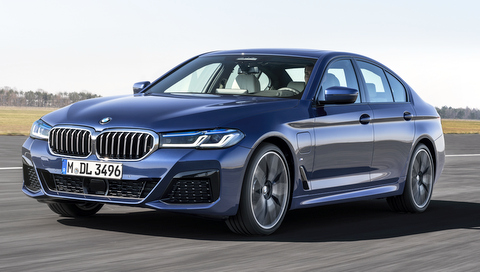
Unlike Tesla, BMW has no identity to establish. Since the 1970’s they’ve built a reputation as “The Ultimate Driving Machine,” and while that may not really apply anymore, the brand still retains a lot of desirability and panache. While they slowly introduce new members of their electric “I” vehicles, they have taken popular models and cleaned them up a bit.
Both the X5 xDrive 45e and the 530e plug-in hybrids retain gasoline engines and the components that support them, like radiators, motor oil and exhaust systems, while installing a motor, battery and an extra port to charge it. But unlike standard hybrids, which have small batteries that charge only when you step on the brake pedal, a plug-in hybrid lets you actively charge your car like an EV—for a limited range.
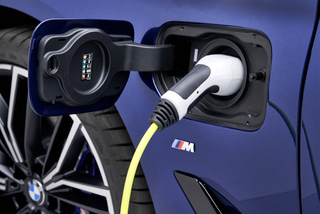
The 530e has an official EPA electric range of 21 miles; the larger battery on the X5 provides 30. What this means in real life is that if you’re willing to plug in your car regularly, for most driving you can go electrically, since statistically, most people don’t drive more than 40 miles a day.
The upsides include lower CO2 emissions, smooth, silent driving and no range anxiety. Once you get past the local electric range, the car converts into hybrid mode and uses gasoline or electricity as efficiently as it can. That means on a freeway trip, if you’re not in stop-and-go traffic, you’ll be using mostly gasoline, while in town, with frequent braking, you may be mostly electric, even if the electrons you put into the battery overnight are used up.
The 2021 BMW X5 xDrive45e Crossover
My Arctic Grey Metallic test unit came packed with extras, making it a seriously luxurious ride. Inside, it wore the Ivory White Vernasca Leather—“non-animal-derived “SensaTec” seating marterial is standard.

The 2021 BMW X5 xDrive45e is a second-generation model, updated significantly from the previous X5 xDrive40e. A more powerful six-cylinder turbo engine replaces the 2.0-liter four from the old car, and the battery doubles in size to 24 kilowatt-hour (kWh). That means you get up to 30 miles of electric-only range vs. just 12 before (I saw my gauge read “32”). That’s significant, because it means a lot more of your local driving will be electric-powered.
The combined horsepower, with the electric motor, is 389 horsepower (hp), a bump of 81 from the old car. Torque jumps as well, to 443 pound-feet (lb.-ft.), a rise of 111. That lets the 5,672-pound hauler sprint from 0-to-60 in just 5.3 seconds.
It takes four hours to charge the battery from empty to 80 percent and 5.3 hours to fill it to 100 percent using a Level 2 240-volt charger. Using standard household current takes considerably longer (13.3 and 17.7 hours respectively). As a plug-in hybrid, it will never need an emergency charging stop while traveling.
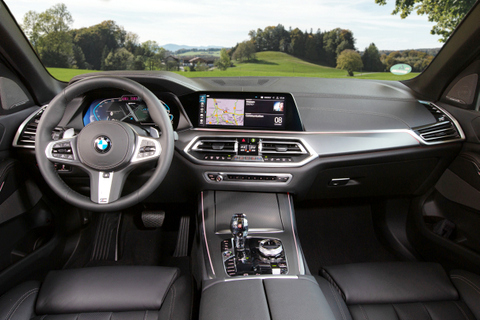
The crossover comes standard with BMW’s Intelligent xDrive all-wheel drive system and an eight-speed Sport Steptronic transmission. It’s smart enough to adjust for your route and driving situation. The double wishbone front and five-link rear suspension are designed for comfort as well as traction when surfaces are less than ideal. The two-axle air suspension balances loads.
The interior looks rugged and luxurious like a BMW crossover should. It features Live Cockpit Professional, with 12.3-inch screens for the instrument panel and in the middle of the dash, where you can control all the sophisticated BMW driving and entertainment options.
My test week was during a quiet February, and with nowhere to go, I took no long rides. But, with its gorgeous chairs, crystal shift knob, and sparkling trim, the car felt quite posh when I did drive locally.
Three Drive Modes
There are three drive modes—Hybrid, Electric and Sport. Hybrid, the default, electronically monitors the route and the road and selects the most efficient or performance-oriented balance of gas or electrons. Electric—my choice—is selectable from a center console button, and I had to do that every time because of the default Hybrid setting.
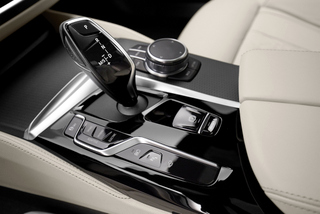
The car can go up to a law-breaking 84 mph on electricity alone, so short freeway hops work just fine. On longer trips you’ll end up in Hybrid mode. If, for some reason, you want to storm back roads for fun, the Sport setting keeps the engine on all the time for extra power.
Since this is nominally an off-road vehicle, you can set five levels of ride height. Although I had no need to use this, it could come in handy for clearance when you leave the highway.
Fuel economy per the EPA is 50 MPGe when you’re using electricity, but it drops way down to 20 mpg with gasoline-only.
The X5 xDrive45e base prices at $65,400, but my tester, loaded up with numerous options, plus $995 shipping from the Spartanburg, South Carolina, factory, came to $81,695. That’s a lot, but it’s a lot of car, too.
The luxury crossover segment is becoming highly desirable these days—low slung sedans are no longer the rage. This car, with its rugged but sophisticated styling and pretty much anything you could want, will fill anyone’s needs and then some. As a plug-in hybrid, if it spends most of its time on local runs and gets charged up regularly, it will function as an EV much of the time. But with all-wheel drive and a gas engine, it will take you to the ski destination of your choice painlessly.
The 2021 BMW 530e Sedan
The BMW 5 Series has enjoyed a long and happy life in the BMW lineup. The 2021 model marks the seventh generation of the “executive size” sedan that debuted in 1972. Larger than the compact 3-Series and smaller than the grand 7-Series, it’s perfect for any driving occasion.
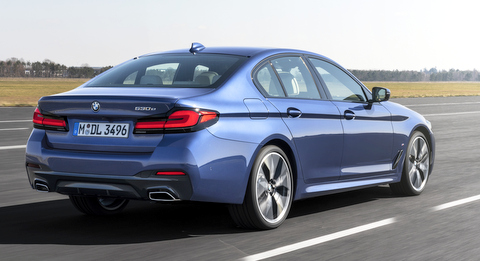
The 530e brings plug-in hybrid power. While both the standard 530i and the 530e have 2.0-liter gas engines, the 530e gets an electric motor with 107 hp and 195 lb.-ft. of torque, making the “e” more powerful, with a total of 288 combined hp and 310 lb.-ft. of torque. The “e” gets from 0-60 0.2 seconds faster as well, at 5.7 seconds.
While the EPA gives the 530i gas-only car fuel economy numbers of 25 mpg city/33 highway/28 combined, the 530e gets 64 MPGe with electricity and gasoline and 26 miles per gallon with gas only. EPA Green scores are 7 for Smog and 8 for Greenhouse Gas.
The 12-kWh battery is tucked out of sight, but it does steal 4 cubic feet of trunk space, while adding weight that makes the 530e about 450 pounds heavier than the 530i.
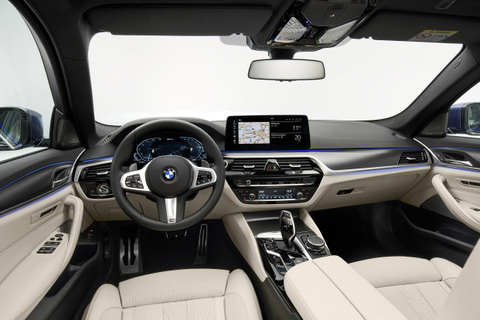
However, it’s still the same 5-Series experience, except you can drive locally without burning gas! With 21 miles of range, the car functions as an electric car around town and for short freeway commutes. You can charge it up at home, at work or while shopping at Whole Foods.
My tester wore a brilliant Phytonic Blue Metallic and featured Ivory White Nappa leather within. BMW leather always smells nice and conveys a premium feel. My tester had a number of packages that added to the luxury and comfort. Driving Assistance Plus includes Extended Traffic Jam Assistant, which, as I am working from home, I didn’t get to try. The Shadowline Package adds extra lighting. The M Sport package brings performance and design upgrades, including variable sport steering, the M Sport suspension, special 19- or 20-inch upgraded rims and an aerodynamic kit. The Parking Assistance Package would have made parking easy, if I had needed it. The Premium Package includes pleasures like a Harman-Kardon audio system and gesture control.

As with any BMW, you can go wild with optional features. My tester base priced at $57,200, but with options plus shipping came to an eye-opening $70,485. For comparison, the base price of the fossil-fuel-only 530i, pre-shipping, is $54,200, $3,000 less than the 530e.
All 5-Series models receive some subtle updates this year, including a larger, taller set of twin kidney grilles along with resculpted LED headlamps up front. Trapezoidal tailpipe finishers perk up the tail end. Inside, Live Cockpit gives you generous 12.3-inch instrument panel and dash center screens. This blends modern computer screen controls with some of the classic feel of the BMWs drivers have loved over the decades.
Most EVs, being silent, can surprise unsuspecting walkers. So, BMW offers Acoustic Protection for Pedestrians, which makes what BMW calls an “unmistakable sound” at up to 19 miles per hour to warn the inattentive.
The 530e does its electric driving subtly, but cruising in it in silence can put you in your happy place, even if it’s not for an extended time. Soon, you’ll be able to enjoy an all-electric midsize sedan from BMW—the i4. Stay tuned.
Make sure to opt-in to the Clean Fleet Report newsletter (top right of page) to be notified of all new stories and vehicle reviews.
Story by Steve Schaefer. Photos by BMW.
Note on BMW PHEV models; the lineup includes:
BMW 330e xDrive (all-wheel drive)
BMW 530e
BMW X5 xDrive45e
Related Stories You Might Enjoy—More Luxury Electrification
News: 2020 Mercedes-Benz EQC 400 EV Makes Its Debut
News: 2019 Mercedes-Benz CLS Adds 48-volt System
Road Test: 2019 Jaguar I-Pace
Road Test: 2021 Lexus LC 500h Hybrid
Road Test: 2020 Lexus NX 300h Hybrid
Road Test: 2020 Lexus RX 450h Hybrid
News: Lexus UX 300e EV Announced
Road Test: 2020 Lexus ES 300h Hybrid
Road Test: 2020 Lexus UX 250h Hybrid
Disclosure:
Clean Fleet Report is loaned free test vehicles from automakers to evaluate, typically for a week at a time. Our road tests are based on this one-week drive of a new vehicle. Because of this we don’t address issues such as long-term reliability or total cost of ownership. In addition, we are often invited to manufacturer events highlighting new vehicles or technology. As part of these events we may be offered free transportation, lodging or meals. We do our best to present our unvarnished evaluations of vehicles and news irrespective of these inducements.
Our focus is on vehicles that offer the best fuel economy in their class, which leads us to emphasize electric cars, plug-in hybrids, hybrids and diesels. We also feature those efficient gas-powered vehicles that are among the top mpg vehicles in their class. In addition, we aim to offer reviews and news on advanced technology and the alternative fuel vehicle market. We welcome any feedback from vehicle owners and are dedicated to providing a forum for alternative viewpoints

@jeniferellzey,
Clean Fleet Report is hosted on Bluehost and they are very helpful and responsive, but loading speed usually comes down to the site content and configuration. It’s critical so it’s worth reading up on. –Ed.